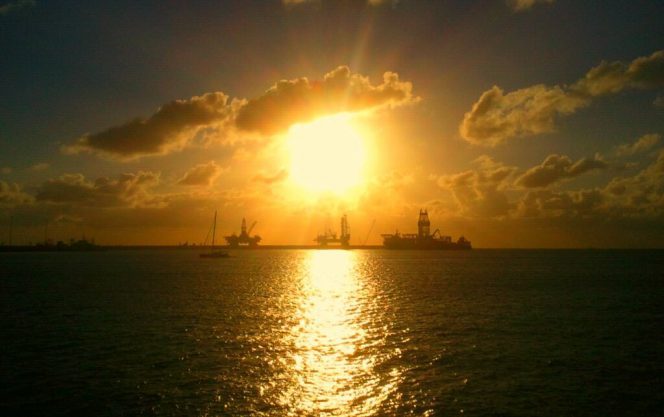With low or no trust in Government competence and performance, many see direct cash transfers of oil revenues to Guyanese households as a means of ensuring all Guyanese realize some tangible benefit from Guyana’s new oil and gas sector. However, how much, to whom, when, and what form or manner, are details that require careful analysis and further discussion.
Recent news articles in Guyanese online news media (Demerara Waves, Sept. 29, 2019; Guyana Chronicle, Sept. 22, 2019; Kaieteur News, multiple dates) reported on well-known Guyanese political activist and economist Dr. Clive Thomas’ arguments in favor of direct cash transfers from Guyana’s oil revenues to Guyanese households. According to those reports, Dr. Thomas articulates the following:
- By 2025, Guyana’s oil production will “soar to about 1 million- to 2.5 million- barrels per day (bpd)”.
- Oil price in 2025 (and beyond) will be $70 (US) per barrel (bbl)
- At $70 per bbl, the Guyana government will be able to set aside at least $1 billion (US) annually for cash transfers to Guyana’s 210,000 households. Each household gets $5,000 (US).
- Transfers would/ should constitute 10% of after tax oil revenues.
This writing is not an attack on Professor Thomas who has been on the forefront of leading positive change in Guyana. Instead, this article examines the underlying assumptions of Dr. Thomas’ cash transfer proposal in the context of factual realities of Guyana’s oil and gas development and crude oil commodity prices.
By 2025, Guyana will produce 750,000 bpd of oil, not 1 million- to 2.5 million- bpd. Based on the Contractor’s (ExxonMobil and its partners) planned development of Guyana’s Stabroek Block, Guyana’s oil production capacity will reach 750,000 bpd by 2025. According to ExxonMobil (majority partner in and operator of the Stabroek Block):
- Beginning in 2020, Liza Phase I will produce up to 120,000 bpd of crude oil,
- In mid-2022, Liza Phase II will boost production by an additional 220,000 bpd
- By early 2023, Payara development comes online with an additional 180,000 bpd, and
- Turbot Area development comes online, in early 2025, with an incremental 230,000 bpd.
Together, these planned Stabroek Block developments combine for a 750,000 bpd crude oil production capacity by 2025. If things go according to plan, Guyana will likely see the 750,000 bpd production in 2025. On the other hand, if there is a significant downturn in major world economies during the next two years, demand for petroleum products could drop sharply for a prolonged period. The latter would result in sustained lower oil prices, and this could delay or scale back Payara and Turbot Area developments. In that scenario, Guyana’s 2025 oil production would be significantly less than 750,000 bpd.
Based on the foregoing discussion, Dr. Thomas’ 1 million- to 2.5 million- bpd production forecast lacks factual foundation and is grossly unrealistic.
Who knows where oil prices will be in 2025; $50, $30, $70 … any guesses? Crude oil is an international commodity traded in all major world commodity markets. World-wide supply and demand factors (including economic recessions, boom cycles, supply disruptions, etc.) and geopolitical events affect the price of crude oil. Moreover, most of the world’s oil supply comes from unstable regions of the world, and thus geopolitics is a significant contributor to oil price uncertainty (i.e., price volatility). Fig. 1 shows the spot price volatility of West Texas Intermediate (WTI) crude oil, from January 1986 to August 12, 2019. In our models, we use WTI as an index for Guyana’s light sweet crude that has similar physical properties.


Without providing any factual support, Dr. Thomas suggests (or perhaps hopes for) sustained oil prices of $70 per bbl in 2025 and beyond. Besides inherent inaccuracy of the $70 per bbl guess, forecasting an inflated crude oil price for planning or policy development purposes is reckless, dangerous, and intellectually dishonest. Crude oil comes with significant price risk, which must be quantified and accounted for by careful and sound technical analysis. Moreover, prudence requires a conservative approach when using oil price forecasts for planning or policy development purposes. For example, with WTI crude oil trading around $52 per bbl today, a responsible price forecast would reflect an expected value (of WTI) that is significantly less than today’s prices.

Cash transfer dividend of $1 billion (US) to Guyanese households by 2025 is technically infeasible. Come 2025, Guyana may not even receive $1 billion (US) in oil revenues, let alone have a $1 billion (US) dividend to transfer to Guyanese households. This is because, in 2025: (1) Guyana will likely produce no more than 750,000 bpd of oil (for reasons discussed previously in this writing), and (2) oil prices will likely be significantly less than $70 per barrel.
Our recent technical analysis of Guyana’s 2020 to 2040 Oil Revenue Outlook & Risk (for production from the Stabroek Block) shows that, in 2025, Guyana’s expected oil revenues are $1.9 billion (US). But, without mitigating price and cost recovery risks, Guyana may realize only $522 million (US) in actual oil revenues. As discussed in our September 17, 2019 article, Guyana’s 2025 revenue risk exposure is an astronomical $1.4 billion (US).
So, if cash transfers to households were 10% of $522 million (US) in actual revenues realized, $52 million (US) would be allocated for distribution to Guyana’s 210,000 households. This would amount to about $248 (US) per household. The billion dollar question is whether those $52 million (and the rest of the oil revenues) could be better invested, by a Guyana government, in needed projects (education & training, infrastructure, existing industry modernization and transformation, electricity from natural gas, etc.) that produce good and measurable returns with sustainable benefits that markedly improve the lives and economic outcomes of all Guyanese citizens.



Just found out Guyana will get Brent pricing for its crude.
Greatly appreciated